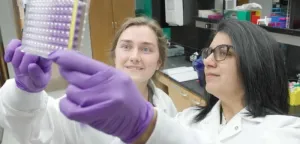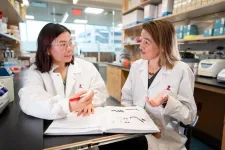(Press-News.org) NEW YORK, NY (July 29, 2024) ---- Underrepresentation of racial and ethnic minority populations in cancer clinical trials persists partly because translation and interpretation services and resources are unavailable or inadequate in the United States, according to a Children’s Oncology Group (COG) study led by Columbia University School of Nursing. The updated study was published online in the Journal of the National Cancer Institute Cancer Spectrum on July 25, 2024 and will appear in the August 2024 journal issue.
In 2019, 68 million people in the United States were reported to speak a language other than English at home. In May 2023, the National Institutes of Health passed the Clinical Trial Diversity Act to enhance the inclusion of women, racially/ethnically diverse individuals, and people of all ages in NIH-funded research, building on 1994 legislation. Despite recent trends and policies, disparities remain.
“Appropriate representation of minoritized and underrepresented populations in clinical research, including persons who do not speak English, is necessary to ensure equitable access to novel treatments and generalizable research findings,” Columbia Nursing Assistant Professor Melissa Beauchemin, PhD, the study’s lead author, and her colleagues state in their report.
To understand the extent of translation and interpretation challenges that organizations face, Beauchemin and her colleagues within the Language Equity Working Group of COG’s Diversity and Health Disparities Committee surveyed 230 COG-affiliated institutions. They found:
Full consent form translation was required at only 50% of institutions.
Twelve percent of institutional review boards restricted the use of centrally translated consent forms.
Forty-six percent of institutions reported insufficient funding to support translation costs; only 15% had access to free translation services.
Forty-four percent were required to use in-person interpreters for consent discussions; lack of available in-person interpreters was the most-cited barrier to obtaining consent.
“These findings show that there are multiple language-specific barriers that make it difficult to recruit people who do not speak English. Eliminating these may be the key to making clinical trials more accessible and universally applicable, while potentially impacting and improving outcomes,” says Beauchemin.
Other study authors include Maria Ortega, MPH, University of Connecticut; Sheila Santacroce, PhD, School of Nursing and Linberger Comprehensive Cancer Center at University of North Carolina at Chapel Hill; Joanna Robles, MD, Wake Forest University Health Sciences; Jenny Ruiz, MD, Children's Hospital of Philadelphia; Anurekha Hall, MD, University of Washington School of Medicine and Seattle Children’s Hospital; Justine Kahn, MD, Manuela Orjuela, MD, and Grace Hillyer, EdD, all from Columbia University Irving Medical Center; Cecilia Fu, MD, Keck School of Medicine, Children’s Hospital of Los Angeles; Samrawit Solomon, BA, Columbia University School of Nursing; Wendy Pelletier, MS, Alberta Children's Hospital; Raul Montiel-Esparza, MD, Prisma Health; Lindsay Blazin, MD, Riley Children's Hospital; Cassie Kline, MD, and Alix E. Seif, MD, all from the Children's Hospital of Philadelphia; Paula Aristizabal, MD, University of California at San Diego; Lena Winestone, MD, University of California San Francisco, Benioff Children’s Hospitals and Helen Diller Family Comprehensive Cancer Center; and Maria Velez, MD, Children's Hospital of New Orleans. Velez is a senior author.
The study was funded by the COG NCORP Research Base Grant. COG, a member of the NCI National Clinical Trials Network (NCTN), is the world’s largest organization devoted exclusively to childhood and adolescent cancer research. COG unites over 10,000 experts in childhood cancer at more than 200 leading children’s hospitals, universities, and cancer centers across North America, Australia, and New Zealand in the fight against childhood cancer. Today, more than 90% of the 16,000 children and adolescents diagnosed with cancer each year in the United States are cared for at COG member institutions. Research performed by COG institutions over the past 50 years has transformed childhood cancer from a virtually incurable disease to one with a combined 5-year survival rate of 80%. COG’s mission is to improve the cure rate and outcomes for all children with cancer.
About Columbia University School of Nursing
Columbia University School of Nursing is advancing nursing education, research, and practice to advance health for all. As one of the top nursing schools in the country, we offer direct-entry master’s degrees, advanced nursing, and doctoral programs with the goal of shaping and setting standards for nursing everywhere. And, as a top recipient of NIH research funding, we address health disparities for under-resourced populations and advance equitable health policy and delivery.
Through our expansive network of clinical collaborations in New York City and around the world —including our dedicated faculty practice, the ColumbiaDoctors Nurse Practitioner Group — we cultivate a culture of innovation and diversity and champion a community-centered approach to care. Across the Columbia Nursing community, we encourage active listening, big thinking, and bold action, so that, together, we’re moving health forward.
Columbia University School of Nursing is part of Columbia University Irving Medical Center, which also includes the Columbia University Vagelos College of Physicians and Surgeons, the Mailman School of Public Health, and the College of Dental Medicine.
END
Better cancer trial representation begins with speaking one’s language
2024-08-06
ELSE PRESS RELEASES FROM THIS DATE:
Social and structural factors are key drivers of disparities in obesity rates
2024-08-06
Obesity is an epidemic in the United States. It has been increasing among adults of all races and ethnicities over the last two decades; however, obesity is higher among Non-Hispanic Black adults, Hispanic adults, and American Indian or Alaska Native adults, than their White and Asian counterparts, according to the National Institutes of Health. Adults with lower income also have higher risk of obesity than those with a high income.
A George Mason University College of Public Health team of interprofessional researchers analyzed the last five years ...
New study helps global MNCs weigh the pros and cons of implementing blockchain technology
2024-08-06
Blockchain technology has become one of the most hyped advancements in recent years, but there hasn’t been a clear understanding of the potential trade-offs for its use by multinational corporations (MNCs). A new study published in the Global Strategy Journal provides a better understanding of blockchain merits and drawbacks by focusing on three particular applications of the technology in this sector: financial transactions, collaboration, and data analytics.
The study, “A perspective on three trade-offs of blockchain technology for the global strategy of the MNC,” was authored by Tuuli Hakkarainen of the University of Liverpool, Anatoli Colicev of the University ...
Increased ventilation not effective in reducing influenza virus spread in play-based model, Emory study finds
2024-08-06
Increasing ventilation in child-care settings may not always be effective at preventing flu virus spread, according to a new study published by a team of researchers at Emory University, University of Pittsburgh School of Medicine, and Virginia Tech.
The spread of flu viruses is commonly studied in animal models that don’t mimic the real-life scenarios of the human experience, making it difficult to evaluate strategies that will be effective in common places where disease spreads rapidly, such as childcare settings. As reported online and in a coming print issue of the journal Proceedings of the National ...
Lonely people tend to have more nightmares, Oregon State University research shows
2024-08-06
CORVALLIS, Ore. – People who are lonely are more apt to have bad dreams, according to a collaboration that included an Oregon State University scientist.
The findings are important because both loneliness and sleep disorders are serious public health issues, said OSU’s Colin Hesse. They are connected to increased risk of heart disease, stroke and premature death.
In a paper published in the Journal of Psychology, Hesse and researchers at the University of Arizona, the University of Tampa and Whitworth University note that stress ...
UC Irvine-led team reveals how TREM2 genetic mutation affects late-onset Alzheimer’s
2024-08-06
Irvine, Calif., Aug. 6, 2024 — Researchers led by the University of California, Irvine have discovered how the TREM2 R47H genetic mutation causes certain brain areas to develop abnormal protein clumps, called beta-amyloid plaques, associated with late-onset Alzheimer’s disease. Leveraging single-cell Merfish spatial transcriptomics technology, the team was able to profile the effects of the mutation across multiple cortical and subcortical brain regions, offering first-of-their-kind insights at the single-cell level.
The study, recently published online in the journal Molecular Psychiatry, compared the brains of normal mice and special mouse models that undergo ...
Considering the patient’s perspective in inducible laryngeal obstruction care
2024-08-06
Inducible laryngeal obstruction is a breathing disorder characterized by unwanted vocal fold closure having the potential to restrict breathing at times.
It’s estimated that between 3-12% of patients with dyspnea complaints have inducible laryngeal obstruction.
Patients with inducible laryngeal obstruction are thought to make up to 22% of patients with frequent emergency room visits due to sudden onset dyspnea.
While experts know how to treat the condition, there’s not much formal research about what patients with the disorder experience ...
Living with a killer: How an unlikely mantis shrimp-clam association violates a biological principle
2024-08-06
Media
When clams gamble on living with a killer, sometimes their luck may run out, according to a University of Michigan study.
A longstanding question in ecology asks how can so many different species co-occur, or live together, at the same time and at the same place. One influential theory called the competitive exclusion principle suggests that only one species can occupy a particular niche in a biological community at any one time.
But out in the wild, researchers find many instances of different species that appear to occupy the same ...
Researchers urge united nations to reject growth-driven framework in favor of lower population and consumption
2024-08-06
In a new peer-reviewed article in The Journal of Population and Sustainability, demographic experts are urging the United Nations to reject the current “‘growth’ paradigm which treats Earth and its nonhuman inhabitants as mere resources” and to take the lead in “contracting the large-scale variables of the human enterprise” in order to “forge a path out of multiple environmental and social crises,” and “reverse our advanced state of ecological overshoot.”
Earth Overshoot Day, the date when humanity’s demand on nature’s resources surpasses Earth’s capacity ...
Future enterovirus outbreaks could be exacerbated by climate change
2024-08-06
Outbreaks of hand, foot and mouth disease (HFMD), which causes fever and rash in young children, typically occur in the summer months. Similarly, historic cases of polio were observed in the summer months in the United States. Both diseases are caused by different species of enteroviruses, a large genus of RNA viruses. However, the drivers of the seasonal patterns of these diseases have remained somewhat unclear.
A common set of drivers can explain the timing of outbreaks of both HFMD and polio according a recent study by researchers at Brown University, Princeton University ...
Genetic ‘episignatures’ guide researchers in identifying causes of unsolved epileptic neurological disorders
2024-08-06
(Memphis, Tenn. – August 6, 2024) To effectively treat a disease or disorder, doctors must first know the root cause. Such is the case for developmental and epileptic encephalopathies (DEEs), whose root causes can be hugely complex and heterogeneous. Scientists at St. Jude Children’s Research Hospital demonstrated the value of DNA methylation patterns for identifying the root cause of DEEs, showing specific gene methylation and genome-wide methylation “episignatures” ...


